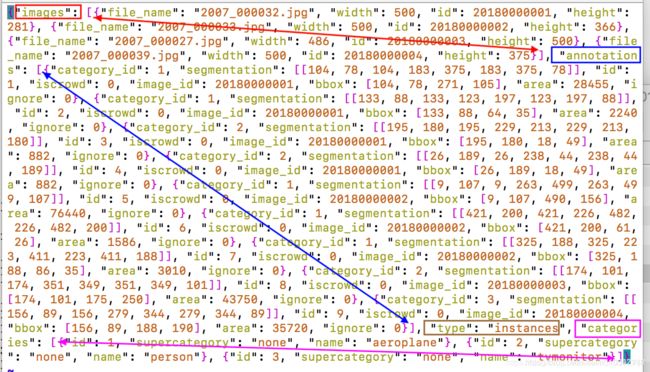把voc格式的标注文件.xml转为coco格式的.json文件
在训练目标检测模型的时候一般使用labelimg标注的图像生产.xml格式的标注文件。有时候需要用到coco格式的json标注文件,在github找到了一个xml转json的脚本。(https://github.com/CivilNet/Gemfield/blob/master/src/python/pascal_voc_xml2json/pascal_voc_xml2json.py)
执行该脚本会读取Annotations下的.xml文件并解析其中的类别及boundbox的坐标,最后生成instances.json的文件。
这里使用了4张图像的xml进行测试。图像名字为2007_000027.jpg 2007_000032.jpg 2007_000033.jpg 2007_000039.jpg。
如下图所示为instances.json文件内容。从下图可以看到,coco的json标注格式实际上是一个大字典{},里面包括了“images”,“annotations”,“type”,"categories"等信息(为了便于观察,图中画出的双箭头表示该属性从开始到结束的范围)。"images"存放每个图像的名字宽高及图像id,"annotations"存放对应相同图像id的图像box的四个坐标位置及该框的类别id,"categories"则表示每个类别id到该类真实名字的对应关系。
#coding:utf-8
# pip install lxml
import os
import glob
import json
import shutil
import numpy as np
import xml.etree.ElementTree as ET
path2 = "."
START_BOUNDING_BOX_ID = 1
def get(root, name):
return root.findall(name)
def get_and_check(root, name, length):
vars = root.findall(name)
if len(vars) == 0:
raise NotImplementedError('Can not find %s in %s.'%(name, root.tag))
if length > 0 and len(vars) != length:
raise NotImplementedError('The size of %s is supposed to be %d, but is %d.'%(name, length, len(vars)))
if length == 1:
vars = vars[0]
return vars
def convert(xml_list, json_file):
json_dict = {"images": [], "type": "instances", "annotations": [], "categories": []}
categories = pre_define_categories.copy()
bnd_id = START_BOUNDING_BOX_ID
all_categories = {}
for index, line in enumerate(xml_list):
# print("Processing %s"%(line))
xml_f = line
tree = ET.parse(xml_f)
root = tree.getroot()
filename = os.path.basename(xml_f)[:-4] + ".jpg"
image_id = 20190000001 + index
size = get_and_check(root, 'size', 1)
width = int(get_and_check(size, 'width', 1).text)
height = int(get_and_check(size, 'height', 1).text)
image = {'file_name': filename, 'height': height, 'width': width, 'id':image_id}
json_dict['images'].append(image)
## Cruuently we do not support segmentation
# segmented = get_and_check(root, 'segmented', 1).text
# assert segmented == '0'
for obj in get(root, 'object'):
category = get_and_check(obj, 'name', 1).text
if category in all_categories:
all_categories[category] += 1
else:
all_categories[category] = 1
if category not in categories:
if only_care_pre_define_categories:
continue
new_id = len(categories) + 1
print("[warning] category '{}' not in 'pre_define_categories'({}), create new id: {} automatically".format(category, pre_define_categories, new_id))
categories[category] = new_id
category_id = categories[category]
还有更多Python的相关学习资料
无法全部放出
QQ 688244617
免费自取
群里还有其他小伙伴跟你一起学习交流
bndbox = get_and_check(obj, 'bndbox', 1)
xmin = int(float(get_and_check(bndbox, 'xmin', 1).text))
ymin = int(float(get_and_check(bndbox, 'ymin', 1).text))
xmax = int(float(get_and_check(bndbox, 'xmax', 1).text))
ymax = int(float(get_and_check(bndbox, 'ymax', 1).text))
assert(xmax > xmin), "xmax <= xmin, {}".format(line)
assert(ymax > ymin), "ymax <= ymin, {}".format(line)
o_width = abs(xmax - xmin)
o_height = abs(ymax - ymin)
ann = {'area': o_width*o_height, 'iscrowd': 0, 'image_id':
image_id, 'bbox':[xmin, ymin, o_width, o_height],
'category_id': category_id, 'id': bnd_id, 'ignore': 0,
'segmentation': []}
json_dict['annotations'].append(ann)
bnd_id = bnd_id + 1
for cate, cid in categories.items():
cat = {'supercategory': 'none', 'id': cid, 'name': cate}
json_dict['categories'].append(cat)
json_fp = open(json_file, 'w')
json_str = json.dumps(json_dict)
json_fp.write(json_str)
json_fp.close()
print("------------create {} done--------------".format(json_file))
print("find {} categories: {} -->>> your pre_define_categories {}: {}".format(len(all_categories), all_categories.keys(), len(pre_define_categories), pre_define_categories.keys()))
print("category: id --> {}".format(categories))
print(categories.keys())
print(categories.values())
if __name__ == '__main__':
classes = ['bicycle', 'pottedplant', 'tvmonitor']
pre_define_categories = {}
for i, cls in enumerate(classes):
pre_define_categories[cls] = i + 1
# pre_define_categories = {'a1': 1, 'a3': 2, 'a6': 3, 'a9': 4, "a10": 5}
only_care_pre_define_categories = True
# only_care_pre_define_categories = False
train_ratio = 0.9
save_json_train = 'instances_train2014.json'
save_json_val = 'instances_val2014.json'
xml_dir = "./tmp_xml"
xml_list = glob.glob(xml_dir + "/*.xml")
xml_list = np.sort(xml_list)
np.random.seed(100)
np.random.shuffle(xml_list)
还有更多Python的相关学习资料
无法全部放出
QQ 688244617
免费自取
群里还有其他小伙伴跟你一起学习交流
train_num = int(len(xml_list)*train_ratio)
xml_list_train = xml_list[:train_num]
xml_list_val = xml_list[train_num:]
convert(xml_list_train, save_json_train)
convert(xml_list_val, save_json_val)
if os.path.exists(path2 + "/annotations"):
shutil.rmtree(path2 + "/annotations")
os.makedirs(path2 + "/annotations")
if os.path.exists(path2 + "/images/train2014"):
shutil.rmtree(path2 + "/images/train2014")
os.makedirs(path2 + "/images/train2014")
if os.path.exists(path2 + "/images/val2014"):
shutil.rmtree(path2 +"/images/val2014")
os.makedirs(path2 + "/images/val2014")
f1 = open("train.txt", "w")
for xml in xml_list_train:
img = xml[:-4] + ".jpg"
f1.write(os.path.basename(xml)[:-4] + "\n")
shutil.copyfile(img, path2 + "/images/train2014/" + os.path.basename(img))
f2 = open("test.txt", "w")
for xml in xml_list_val:
img = xml[:-4] + ".jpg"
f2.write(os.path.basename(xml)[:-4] + "\n")
shutil.copyfile(img, path2 + "/images/val2014/" + os.path.basename(img))
f1.close()
f2.close()
print("-------------------------------")
print("train number:", len(xml_list_train))
print("val number:", len(xml_list_val))
